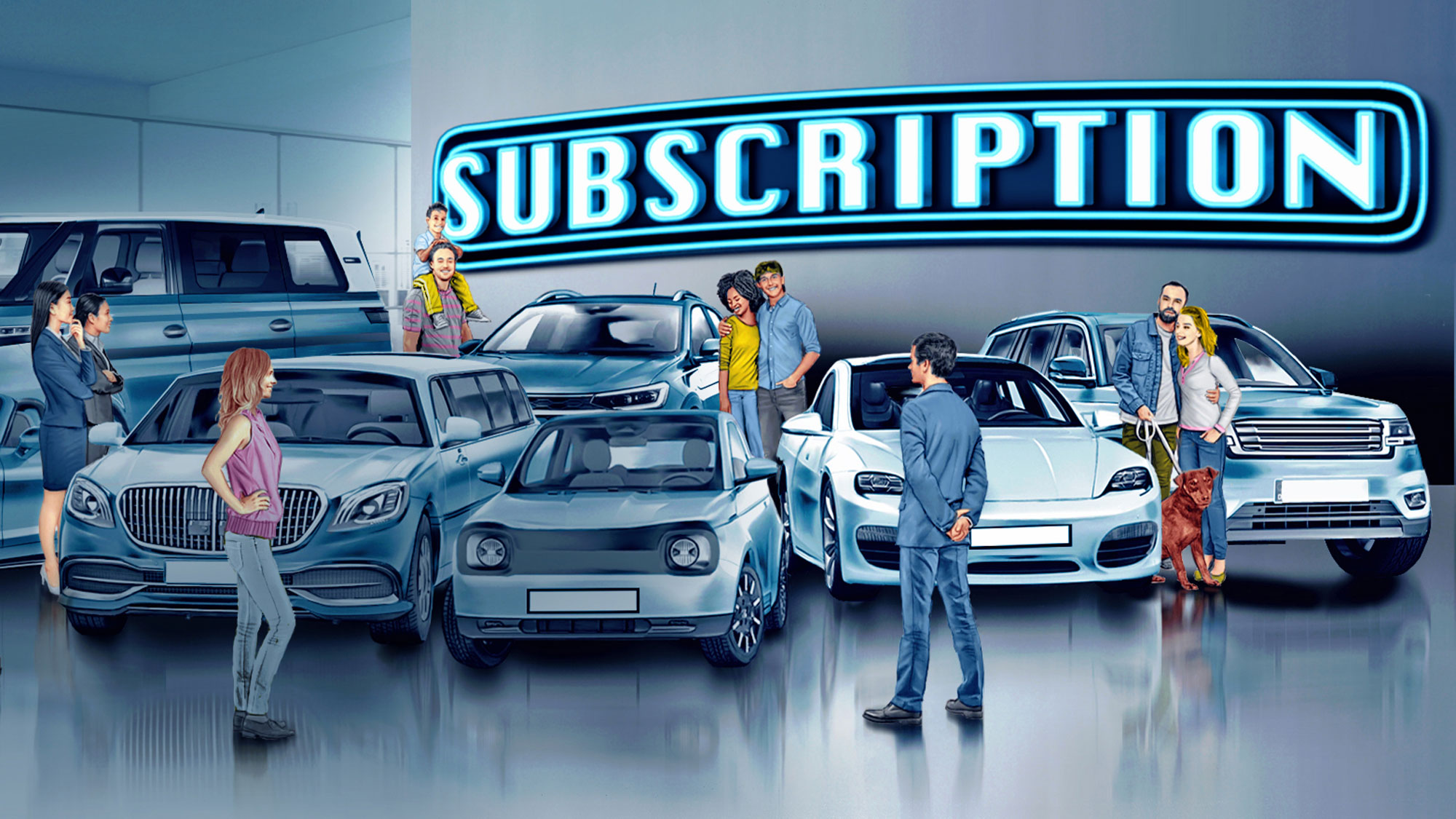A World of Cars
in One Subscription
The automotive industry is reinventing itself. As it must. And not only in terms of the drive. Customers want independence, more flexibility, and less capital commitment. Suppliers are responding.
12/2022

People want to be mobile. The invention of the steamship 300 years ago was a milestone. It was followed in 1825 by the first railroad, then the airplane and the automobile—and a car at your doorstep quickly became a status symbol. As a result of social issues such as sustainability and climate protection, as well as the development towards what is known as the sharing economy—the temporary lending or sharing of vehicles, for example—the number of people who have changed their demands regarding automobility has grown rapidly in recent years. And demand is transforming what is being offered. One of the new products is the car subscription.
Subscription contracts for magazines, TV, and music streaming services are classics. But does this also work for cars? The first providers of vehicles at flat-rate tariffs rolled onto the market in 2017. Initially, they were mainly independent start-ups. Then Volvo, Jaguar Land Rover and a handful of other manufacturers followed. As a rule, the in-house financial service organizations at the manufacturers’ headquarters assume operational responsibility. They are, as it were, the automotive banks that traditionally handle vehicle financing and leasing.
Conventional car rental companies such as Europcar, Hertz, and Sixt have also jumped on the bandwagon. And it has picked up speed. Small cars such as the Opel Corsa and mid-size and luxury sedans such as the Volkswagen Passat and the Audi A4 are all available on a subscription basis. But also sports cars like the Porsche 911. Demand for car subscriptions is growing rapidly. According to a Porsche Consulting estimate, in 2021 the number of contracts concluded in Germany already exceeded 50,000. The principle: customers pay a flat monthly fee for use of the vehicle during the contract period. All costs are included in the monthly installment: maintenance, wear and tear, general inspection, insurance, motor vehicle taxes. As a subscriber, the customer only has to pay for fuel—or electricity in the case of an electric car—plus a trip to the car wash and a refill of operating supplies.

What is the difference between car subscription and car leasing? First of all, the term of the contract is shorter: while leasing requires a commitment for at least twelve months, some car subscription providers entice customers with a term of just one month. Six- or nine-month contract periods are also feasible. The cost per month for the car ranges from a few hundred euros to over 3,000 euros, depending on the make and model. In the vast majority of vehicles available, the equipment is already configured. Changes are generally not possible. The terms of the contract and details such as registration fee, minimum age (between 18 and 25 years, depending on the provider), number of additional authorized drivers listed on the contract, delivery period, or mileage allowance are similar to those for long-term rental cars. If a subscriber drives more kilometers than agreed, they usually also have to pay extra for these at the end. As with leasing, users do not own the vehicle.
But how do companies benefit from this business model? The majority of subscription providers are more concerned with medium- and long-term goals in this new market. Many providers are currently investing in these new business models in order to find out how great the potential is. A 2020 study by the market research institute Puls reveals that the greatest appeal is for 30- to 50-year-olds; nearly 40 percent of respondents in this age group find car subscription offers “very interesting.” The car subscription is also suitable as a test market for electromobility products, as some interested parties use it to find out whether an electric vehicle would make sense for them in day-to-day life. Volume manufacturers, who produce millions of vehicles a year, also use car subscriptions to give one model or another from their model range a little extra push. Leasing and car-sharing returns can also be remarketed through subscriptions.
Porsche Financial Services (PFS) launched the first car subscription model for the Porsche family brand back in 2020. Along with addressing additional target groups, PFS was also directing a focus on establishing a sustainable and economical business model as an additional pillar for the core business. Porsche Drive subscription service is intended to give Porsche customers and prospective customers an opportunity to “react flexibly to changing life circumstances while enjoying the fun of driving a Porsche,” says Christoph Köhler, Senior Consultant in the Mobility Services division at the management consultancy Porsche Consulting. Together with his colleagues, he assisted the auto finance experts at the sports-car manufacturer’s PFS subsidiary with the subscription.
Fulfilling dreams on time

Porsche relies on a minimum term of six months, with a notice period of three months. The cost of the subscription depends on the model and its equipment. For the Porsche 911, for example, these costs range from 2,800 to 3,500 euros.
Porsche Consulting supports the Stuttgart-based sports-car manufacturer in developing innovative business models. Christoph Köhler says, “We assist Porsche with car subscription along the entire value creation path.” Porsche Consulting is successful because it is able to test new ideas directly on the market. “Our Service Development approach allows us to validate innovations on the market with real customers within just a few weeks, without creating a direct link to the brand,” explains Köhler. In addition, Porsche Consulting’s expertise in the automotive world enables it to provide analyses and optimization, prepare business calculations, and support the establishment of agile product organizations.
Porsche, a premium supplier, has continued developing its subscription model in the interim. A second business model pillar has emerged: Porsche Drive Flex. What’s particularly attractive is the free choice of model during the subscription period: 911 today, Cayenne tomorrow, Taycan the day after. As Christoph Köhler notes, “Whether it’s the way to the office, weekend driving pleasure, a family outing, or a road trip with friends—the customer has maximum flexibility, can change vehicles quickly and easily within the versatile fleet.” The fixed monthly price comes to 2,899 euros. The minimum term for Porsche Drive Flex is three months, and the notice period is one month.
